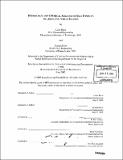| dc.contributor.advisor | E. Eric Adams and Peter Shanahan. | en_US |
| dc.contributor.author | Bossi, Liam, 1979- | en_US |
| dc.contributor.author | Rose, Donald, 1978- | en_US |
| dc.contributor.other | Massachusetts Institute of Technology. Dept. of Civil and Environmental Engineering. | en_US |
| dc.date.accessioned | 2005-10-14T19:53:10Z | |
| dc.date.available | 2005-10-14T19:53:10Z | |
| dc.date.copyright | 2003 | en_US |
| dc.date.issued | 2003 | en_US |
| dc.identifier.uri | http://hdl.handle.net/1721.1/29328 | |
| dc.description | Thesis (M.Eng.)--Massachusetts Institute of Technology, Dept. of Civil and Environmental Engineering, 2003. | en_US |
| dc.description | Includes bibliographical references (p. 81-83). | en_US |
| dc.description.abstract | In order to assess the impact of human development on salt ponds, this study investigated the relationships between the chemistry of salt ponds and the hydrology of the surrounding area. Aspects of pond health such as nutrient levels, sedimentation parameters, and water quality indicators were analyzed in conjunction with development metrics, watershed descriptions, and runoff characteristics. Salt ponds were determined to be composed primarily of evaporated seawater. This determination was based on the outputs of hydrologic modeling, which predicted minimal inputs due to surface runoff, plus the results of regression analyses, which showed significant correlation between nutrient levels and salinity (R 2=0.885) and minimal deviation of measured nutrient concentrations from those predicted by evaporation. In addition, the feasibility of groundwater seepage measurement was investigated, as this seepage could play a key role in determining the role that human development may play in salt pond chemistry. Southside Pond, which met all the criteria necessary for seepage meter deployment, was analyzed for groundwater inputs; however, the information collected showed no evidence of significant groundwater inputs. | en_US |
| dc.description.statementofresponsibility | by Liam Bossi and Donald Rose. | en_US |
| dc.format.extent | 136 p. | en_US |
| dc.format.extent | 6859832 bytes | |
| dc.format.extent | 6859636 bytes | |
| dc.format.mimetype | application/pdf | |
| dc.format.mimetype | application/pdf | |
| dc.language.iso | eng | en_US |
| dc.publisher | Massachusetts Institute of Technology | en_US |
| dc.rights | M.I.T. theses are protected by copyright. They may be viewed from this source for any purpose, but reproduction or distribution in any format is prohibited without written permission. See provided URL for inquiries about permission. | en_US |
| dc.rights.uri | http://dspace.mit.edu/handle/1721.1/7582 | |
| dc.subject | Civil and Environmental Engineering. | en_US |
| dc.title | Hydrologic and chemical analysis of salt ponds on St. John, U.S. Virgin Islands | en_US |
| dc.type | Thesis | en_US |
| dc.description.degree | M.Eng. | en_US |
| dc.contributor.department | Massachusetts Institute of Technology. Department of Civil and Environmental Engineering | |
| dc.identifier.oclc | 52718312 | en_US |
